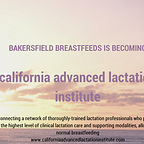Normal Infant Feeding: Finding Our Way Back
Leading The Way Back to Normal Infant Feeding
Whose responsibility is it to re-direct policies, procedures, and attitudes back in the direction of Normal Infant Feeding (NIF)? Those who recognize that it is their obligation and those who accept that it is their ethical responsibility search fervently for useful guidance on effecting change. Statistics on how babies are feeding before their parents even get them home from the hospital are clearly showing that NIF remains poorly understood, weakly championed, and vastly unsupported by cultural norms. Altering momentum in the direction of NIF needs to happen on many levels, and here are some places it must be shifted if maternal/child health outcomes are to be improved.
1. Defining Normal Infant Feeding (NIF)
Normal Infant Feeding (NIF) is defined as an infant feeding at breast beginning at birth and doing so exclusively until at least the age of 6 months, after which time complementary solid foods are gradually added to the infant’s diet as breastfeeding continues. Normal, healthy term infants are born able and willing to feed at the breast. If they cannot, the cause(s) must be identified and then the infant’s parents provided with appropriate education and skills to ensure NIF can resume as soon as possible. When infants are born early, ill, or with structural issues affecting feeding, appropriate consultation with NIF experts such as International Board Certified Lactation Consultants (IBCLCs) is crucial to ensuring optimal outcomes for these at-risk populations. http://ibclcinca.wordpress.com/2012/12/17/ibclc-the-fixer/
2. Defining Infant Feeding Interventions
Interventions to assist infants with feeding must be research-proven, not just used due to custom or tradition. Interventions currently promoted and used, including bottlefeeding mother’s own milk or artificial milk, are often NOT the evidence-based first choice for ensuring NIF can be resumed. Interventions must be clearly defined as such and labeled properly with an ending date or benchmark. Without those precautions, the intervention becomes the routine and NIF is discarded and devalued. See previous post here http://ibclcinca.wordpress.com/2012/11/12/breastfeeding-is-not-expendable/
3. Creating Efficient Breastfeeding Policy in Healthcare Environments
Policy writers need not re-invent the wheel as many existing NIF models have been created and are widely available for adoption. The Baby-Friendly Hospital Initiative and the Academy of Breastfeeding Medicine Protocols are two well-known and widely-accepted standards. These models incorporate the preponderance of evidence regarding procedures for protecting NIF and the interventions which are appropriate for alternate scenarios. http://ibclcinca.wordpress.com/2013/04/03/the-first-100-hours-a-refreshing-idea-in-breastfeeding/
4. Applying Research Ethically
Meta-analyses are, in this day and age, close to the best way available to factor all existing evidence into a practical conclusion. When available, meta-analyses should be the basis for incorporating ideas and practices. Research is frequently released which is industry-influenced and/or poorly structured. When using single studies, whether large or small, a person trained to evaluate research should be thoroughly assessing the study or publication before its conclusions are accepted and put to use.
5. Centering Care Decisions on the NIF Model
Simply asking the question “How will this care plan affect NIF in the short- and long-term?” is a critical step for all providers caring for mothers and young children. One caveat: a solid understanding of how interventions affect long-term outcomes is necessary for this step to work properly — simply assuming that it will work itself out or blindly assigning intervention because it’s the way one has always done it is not appropriate care. Assuming personal responsibility for ensuring a mother has the correct information when intervention is suggested is the ONLY way for the provider to ensure the mother can make informed consent.
The path back to Normal Infant Feeding is being illuminated by many IBCLCs, nurses, physicians, lactation educators, doulas, midwives, and countless others who provide mothers with excellent breastfeeding support. This tireless group leads the conversation about NIF on a one-to-one level with mothers as well as in the public eye. As 2013 comes to a close, we thank these people for holding high their lanterns as they lead mothers and babies to a more hopeful and healthier future.
Want to read more about lactation advocacy and messages of hope?http://ibclcinca.wordpress.com/2013/04/30/attitudes-perspectives-breastfeeding/
